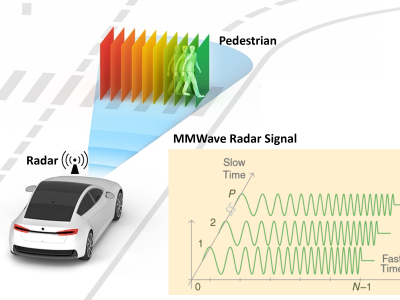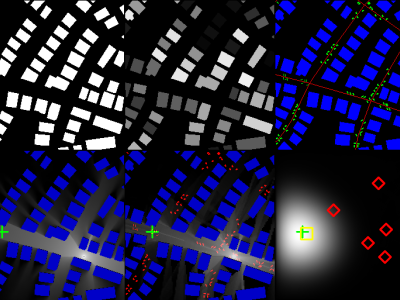CRAWDAD rutgers/ap_density

- Citation Author(s):
-
Mesut Ali Ergin (Rutgers, The State University of New Jersey)Marco GruteserKishore Ramachandran
- Submitted by:
- CRAWDAD Team
- Last updated:
- DOI:
- 10.15783/C7FW2D
 275 views
275 views
- Categories:
Abstract
This dataset includes realistic client arrival patterns and realistic application workloads that are used to evaluate effects of high-density deployments of interfering access points to IEEE 802.11 WLAN performance. Both wired and wireless frame dump traces are provided from the experiments in ORBIT wireless research testbed involving four access points and seventy-five stations.
last modified :
2007-09-21release date :
2007-08-09date/time of measurement start :
2007-01-11date/time of measurement end :
2007-01-11collection environment :
Experiments are conducted to measure effects of having multiple interfering APs that serve many users with realistic traffic workloads.network configuration :
The experiments were performed on the 400-node grid of ORBIT, wireless research testbed. Placement of nodes follow a high density grid-type deployment in a 20 meters by 20 meters isolated area with approximately 1 meter inter-node distances. ORBIT provides access to small form factor PCs with 1GHz Via C3 CPU, 512 MB RAM, 20 GB hard disk, three Gbps ethernet ports, and two Atheros AR5002X Mini PCI 802.11a/b/g (AR5212 MAC Baseband Processor + AR5112 Dual-band Radio-on-a-Chip) WLAN adapters. We have used GNU/Linux operating system with 2.6.18 series kernel, and Madwifi driver svn revision 2118. For access points, we have used Madwifi driver's AP mode with transparent bridging to that particular ORBIT node's Gbps Ethernet interface. All application services (WWW, and D-ITG -- VoIP and Exponential traffic) are also hosted on ORBIT nodes that are connected to the same switched Gbps data backbone.data collection methodology :
Traceset
rutgers/ap_density/workload
Traceset of realistic client arrival patterns and application traffic workloads.
- files: sta_arrivals.txt, realisticTraffic.tgz
- description: This traceset includes realistic client arrival patterns and realistic application workloads that are used to evaluate effects of high-density deployments of interfering access points to IEEE 802.11 WLAN performance.
- measurement purpose: Network Performance Analysis
- methodology: The experiments are conducted to measure effects of having multiple interfering APs that serve many users with realistic traffic workloads as follows: - Clients follow an arrival pattern to associate with the AP(s). The station arrival pattern was created similar to the real users returning from lunch at the 64th IETF conference. (The trace rutgers/ap_density/workload/sta_arrivals contains the arrival pattern.) - As clients arrive, they select an application profile (WWW, exponential traffic, or VoIP) randomly to match the percentage of traffic distribution that is observed in a typical office setting. After selecting their profiles, clients start the application session and generate traffic until the end of the experiment. (The trace rutgers/ap_density/workload/realisticTraffic contains the traffic workload.)
- last modified: 2007-09-21
- dataname: rutgers/ap_density/workload
- version: 20070809
- change: the initial version
- release date: 2007-09-21
- date/time of measurement start: 2007-01-11
- date/time of measurement end: 2007-01-11
- network type: 802.11 infrastructure
rutgers/ap_density/workload Traces
- sta_arrivals: Trace of station inter-arrival times.
- configuration: This file contains station inter-arrival times in seconds at each line for a total of 75 stations. A control loop like: for (i=1;i<75;i++) { create_station(i); sleep( read_line(i, sta_arrivals.txt) ); } will create station arrival patterns similar to the real users returning from lunch at the 64th IETF conference. This arrival pattern is extracted from the UCSB 64nd IETF conference traces. In processing those traces, a station is assumed to be inactive if no IP traffic (both directions) is detected for more than five minutes for that particular node. First 75 inactive nodes that start communication after the lunch hour are captured in the trace file.
- format: Plain Text (UNIX CR/LF)
- description: This trace contains station inter-arrival times in seconds at each line for a total of 75 stations.
- last modified: 2007-09-21
- dataname: rutgers/ap_density/workload/sta_arrivals
- version: 20070809
- change: the initial version
- release date: 2007-09-21
- date/time of measurement start: 2007-01-11
- date/time of measurement end: 2007-01-11
- url: /download/rutgers/ap_density/workload/sta_arrivals.txt
- realisticTraffic: Trace of a synthetic office traffic workload.
- configuration: Since inter-cell interference is affected by end-user workloads, we constructed a synthetic office work-load in addition to bulk TCP-only workloads we used in PER experiments. The office workload is based on sniffer measurements obtained in our academic office environment for a single access point serving about 50 students and faculty. These measurements indicate that 97% of packets use the TCP protocol and about 75% of traffic is generated by web traffic. These measurements are reasonably consistent with (except for a 20% increase in web traffic) an earlier analysis of SIGCOMM 2001 conference traces covering 4 APs and 195 stations. Bursty web traffic in our workload follows the self-similar ON-OFF traffic model given by Barford and Crovella (ACM SIGMETRICS 1998). We emulate the HTML transfer, browser processing, and HTML object retrieval phases with wget page retrieval tool. User's thinking time X between page accesses is Pareto distributed, with parameters k=1.5 and x_m=1, as suggested by Barford and Crovella. The remaining share of the workload comprises a mix of VoIP traffic (over UDP/IP) using the G.711 codec with H.323 signalling (3% of overall volume), and TCP packet transfers with exponentially distributed interarrival times (21% of the overall volume on average) as background traffic. These flows are emulated using the D-ITG traffic generator v.2.4.3.
- format: Plain Text Files (UNIX CR/LF in GZip Compressed Tar) In the provided trace collection, three files are included: paretoSamples.txt, objectSizes.txt, DITG_samples.txt. Pareto sample file is from one instantiation of our pareto random number generator, giving user thinking time values (over 500K values) distributed between 15 and 100 (seconds). Object size file is a collection of the sizes (in bytes) of random web objects (from http://www.winlab.rutgers.edu website). These objects include plain html pages, html pages with images, and various file downloads (presentation files, source code tarballs, etc.). The way to generate WWW traffic using these traces should be as follows: Each node uses a disjoint part of the pareto sample file and requests a random object (of sizes listed in objectSizes.txt) by calling wget to a web server (e.g., Apache httpd, or MS IIS) that serves objects of these sizes. Then node goes to sleep (emulation of browsing and thinking) for an interval given by the next value in paretoSamples.txt file. Process continues with another random object from the list. The rest of the realistic traffic pattern (as explained above) is created by DITG and examples of how we created exponential and CBR type TCP traffic, and VoIP traffic are provided in DITG_samples.txt file.
- description: This trace contains a synthetic office work-load based on sniffer measurements obtained in our academic office environment for a single access point serving about 50 students and faculty.
- last modified: 2007-09-21
- dataname: rutgers/ap_density/workload/realisticTraffic
- version: 20070809
- change: the initial version
- release date: 2007-09-21
- date/time of measurement start: 2007-01-11
- date/time of measurement end: 2007-01-11
- url: /download/rutgers/ap_density/workload/realisticTraffic.tgz
rutgers/ap_density/wired
Traceset of wired frame dump traces collected from experiments in the ORBIT testbed.
- files: 1AP_75STA.dump.tgz, 2AP_75STA.dump.tgz, 3AP_75STA.dump.tgz, 4AP_75STA.dump.tgz
- description: This traceset includes wired frame dump traces collected from the experiments in ORBIT wireless research testbed involving four access points and seventy-five stations.
- measurement purpose: Network Performance Analysis
- methodology: The experiments are conducted to measure effects of having multiple interfering APs that serve many users with realistic traffic workloads. The AP and clients use IEEE 802.11a protocol on channel 52 which is confirmed to be unoccupied throughout the experiment. Clients follow an arrival pattern (see rutgers/ap_density/workload/ap_arrivals) to associate with the AP(s). If more than one AP is available, default AP selection algorithm on driver is used (highest RSSI AP gets picked). As clients arrive, they select an application profile (WWW, exponential traffic, or VoIP) randomly to match the percentage of traffic distribution that is observed in a typical office setting. After selecting their profiles, clients start the application session and generate traffic until the end of the experiment. Cumulative system throughput (as measured flowing between APs and application server) determined system performance in hauling traffic back and forth between wired and wireless networks. Multiple runs of the same experiment resulted in similar behaviors, thus only the traces from one instance of each experiment are made available to public.
- last modified: 2007-09-21
- dataname: rutgers/ap_density/wired
- version: 20070809
- change: the initial version
- release date: 2007-09-21
- date/time of measurement start: 2007-01-11
- date/time of measurement end: 2007-01-11
- network type: 802.11 infrastructure
rutgers/ap_density/wired Traces
- 1AP_75STA: Traffic Dump for 1 AP 75 STA Experiment.
- configuration: - Traffic Dump for 1 AP 75 STA Experiment This file contains a frame dump file as seen from the wired port of the access point(s), for the application traffic travelling between wireless stations and application servers. The volume of this traffic is considered to be a metric for the performance of the WLAN under experimentation, since WLAN is deployed to haul traffic back and forth between wired and wireless networks. Trace starts at UNIX epoch 1168535241 and finishes at 1168535821 (i.e. lasting approximately 10 minutes). These traces are from the experiments that use the realistic traffic workload as explained above.
- format: TCPDump File (GZip Compressed Tar)
- description: Traffic Dump for 1 AP 75 STA Experiment.
- last modified: 2007-09-21
- dataname: rutgers/ap_density/tcpdump/1AP_75STA
- version: 20070809
- change: the initial version
- release date: 2007-09-21
- date/time of measurement start: 2007-01-11
- date/time of measurement end: 2007-01-11
- url: /download/rutgers/ap_density/tcpdump/1AP_75STA.dump.tgz
- 2AP_75STA: Traffic Dump for 2 AP 75 STA Experiment.
- configuration: - Traffic Dump for 2 AP 75 STA Experiment This file contains a frame dump file as seen from the wired port of the access point(s), for the application traffic travelling between wireless stations and application servers. The volume of this traffic is considered to be a metric for the performance of the WLAN under experimentation, since WLAN is deployed to haul traffic back and forth between wired and wireless networks. Trace starts at UNIX epoch 1168540183 and finishes at 1168540763 (i.e. lasting approximately 10 minutes). These traces are from the experiments that use the realistic traffic workload as explained above.
- format: TCPDump File (GZip Compressed Tar)
- description: Traffic Dump for 2 AP 75 STA Experiment.
- last modified: 2007-09-21
- dataname: rutgers/ap_density/tcpdump/2AP_75STA
- version: 20070809
- change: the initial version
- release date: 2007-09-21
- date/time of measurement start: 2007-01-11
- date/time of measurement end: 2007-01-11
- url: /download/rutgers/ap_density/tcpdump/2AP_75STA.dump.tgz
- 3AP_75STA: Traffic Dump for 3 AP 75 STA Experiment.
- configuration: - Traffic Dump for 3 AP 75 STA Experiment This file contains a frame dump file as seen from the wired port of the access point(s), for the application traffic travelling between wireless stations and application servers. The volume of this traffic is considered to be a metric for the performance of the WLAN under experimentation, since WLAN is deployed to haul traffic back and forth between wired and wireless networks. Trace starts at UNIX epoch 1168542112 and finishes at 1168542752 (i.e. lasting approximately 10 minutes). These traces are from the experiments that use the realistic traffic workload as explained above.
- format: TCPDump File (GZip Compressed Tar)
- description: Traffic Dump for 3 AP 75 STA Experiment.
- last modified: 2007-09-21
- dataname: rutgers/ap_density/tcpdump/3AP_75STA
- version: 20070809
- change: the initial version
- release date: 2007-09-21
- date/time of measurement start: 2007-01-11
- date/time of measurement end: 2007-01-11
- url: /download/rutgers/ap_density/tcpdump/3AP_75STA.dump.tgz
- 4AP_75STA: Traffic Dump for 4 AP 75 STA Experiment.
- configuration: - Traffic Dump for 4 AP 75 STA Experiment This file contains a frame dump file as seen from the wired port of the access point(s), for the application traffic travelling between wireless stations and application servers. The volume of this traffic is considered to be a metric for the performance of the WLAN under experimentation, since WLAN is deployed to haul traffic back and forth between wired and wireless networks. Trace starts at UNIX epoch 1168543425 and finishes at 1168544065 (i.e. lasting approximately 10 minutes). These traces are from the experiments that use the realistic traffic workload as explained above.
- format: TCPDump File (GZip Compressed Tar)
- description: Traffic Dump for 4 AP 75 STA Experiment.
- last modified: 2007-09-21
- dataname: rutgers/ap_density/tcpdump/4AP_75STA
- version: 20070809
- change: the initial version
- release date: 2007-09-21
- date/time of measurement start: 2007-01-11
- date/time of measurement end: 2007-01-11
- url: /download/rutgers/ap_density/tcpdump/4AP_75STA.dump.tgz
rutgers/ap_density/wireless
Traceset of wireless frame dump traces collected from experiments in the ORBIT testbed.
- files: 1AP_4STA.dump.tgz, 1AP_8STA.dump.tgz, 1AP_16STA.dump.tgz, 2AP_4STA.dump.tgz, 2AP_8STA.dump.tgz, 2AP_16STA.dump.tgz
- description: This traceset includes wireless frame dump traces collected from the experiments in ORBIT wireless research testbed involving four access points and seventy-five stations.
- measurement purpose: Network Performance Analysis
- methodology: The experiments are conducted to measure effects of having multiple interfering APs that serve many users with realistic traffic workloads. The AP and clients use IEEE 802.11a protocol on channel 52 which is confirmed to be unoccupied throughout the experiment. Clients follow an arrival pattern (see rutgers/ap_density/workload/ap_arrivals) to associate with the AP(s). If more than one AP is available, default AP selection algorithm on driver is used (highest RSSI AP gets picked). As clients arrive, they select an application profile (WWW, exponential traffic, or VoIP) randomly to match the percentage of traffic distribution that is observed in a typical office setting. After selecting their profiles, clients start the application session and generate traffic until the end of the experiment. Cumulative system throughput (as measured flowing between APs and application server) determined system performance in hauling traffic back and fort between wired and wireless networks. Multiple runs of the same experiment resulted in similar behaviors, thus only the traces from one instance of each experiment are made available to public.
- last modified: 2007-09-21
- dataname: rutgers/ap_density/wireless
- version: 20070809
- change: the initial version
- release date: 2007-09-21
- date/time of measurement start: 2007-01-11
- date/time of measurement end: 2007-01-11
- network type: 802.11 infrastructure
rutgers/ap_density/wireless Traces
- 1AP_4STA: Wireless Traffic Dump for 1 AP 4 STA Experiment.
- configuration: - Wireless Traffic Dump for 1 AP 4 STA Experiment This file contains a frame dump file as seen by a wireless sniffer placed in the close vicinity of the WLAN being tested. There is no other process on the wireless sniffer and this trace is later used to derive PER statistics due to collisions together with driver packet error statistics from stations and AP(s). Due to the nature of the experiment, workload is constructed from clients to a central server by using 1300-byte frames sent using TCP at the maximum possible pace TCP allows. Trace lasts about five minutes.
- format: TCPDump File (GZip Compressed Tar)
- description: Wireless Traffic Dump for 1 AP 4 STA Experiment.
- last modified: 2007-09-21
- dataname: rutgers/ap_density/tcpdump/1AP_4STA
- version: 20070809
- change: the initial version
- release date: 2007-09-21
- date/time of measurement start: 2007-01-11
- date/time of measurement end: 2007-01-11
- url: /download/rutgers/ap_density/tcpdump/1AP_4STA.dump.tgz
- 1AP_8STA: Wireless Traffic Dump for 1 AP 8 STA Experiment.
- configuration: - Wireless Traffic Dump for 1 AP 8 STA Experiment This file contains a frame dump file as seen by a wireless sniffer placed in the close vicinity of the WLAN being tested. There is no other process on the wireless sniffer and this trace is later used to derive PER statistics due to collisions together with driver packet error statistics from stations and AP(s). Due to the nature of the experiment, workload is constructed from clients to a central server by using 1300-byte frames sent using TCP at the maximum possible pace TCP allows. Trace lasts about five minutes.
- format: TCPDump File (GZip Compressed Tar)
- description: Wireless Traffic Dump for 1 AP 8 STA Experiment.
- last modified: 2007-09-21
- dataname: rutgers/ap_density/tcpdump/1AP_8STA
- version: 20070809
- change: the initial version
- release date: 2007-09-21
- date/time of measurement start: 2007-01-11
- date/time of measurement end: 2007-01-11
- url: /download/rutgers/ap_density/tcpdump/1AP_8STA.dump.tgz
- 1AP_16STA: Wireless Traffic Dump for 1 AP 16 STA Experiment.
- configuration: - Wireless Traffic Dump for 1 AP 16 STA Experiment This file contains a frame dump file as seen by a wireless sniffer placed in the close vicinity of the WLAN being tested. There is no other process on the wireless sniffer and this trace is later used to derive PER statistics due to collisions together with driver packet error statistics from stations and AP(s). Due to the nature of the experiment, workload is constructed from clients to a central server by using 1300-byte frames sent using TCP at the maximum possible pace TCP allows. Trace lasts about five minutes.
- format: TCPDump File (GZip Compressed Tar)
- description: Wireless Traffic Dump for 1 AP 16 STA Experiment.
- last modified: 2007-09-21
- dataname: rutgers/ap_density/tcpdump/1AP_16STA
- version: 20070809
- change: the initial version
- release date: 2007-09-21
- date/time of measurement start: 2007-01-11
- date/time of measurement end: 2007-01-11
- url: /download/rutgers/ap_density/tcpdump/1AP_16STA.dump.tgz
- 2AP_4STA: Wireless Traffic Dump for 2 AP 4 STA Experiment.
- configuration: - Wireless Traffic Dump for 2 AP 4 STA Experiment This file contains a frame dump file as seen by a wireless sniffer placed in the close vicinity of the WLAN being tested. There is no other process on the wireless sniffer and this trace is later used to derive PER statistics due to collisions together with driver packet error statistics from stations and AP(s). Due to the nature of the experiment, workload is constructed from clients to a central server by using 1300-byte frames sent using TCP at the maximum possible pace TCP allows. Trace lasts about five minutes.
- format: TCPDump File (GZip Compressed Tar)
- description: Wireless Traffic Dump for 2 AP 4 STA Experiment.
- last modified: 2007-09-21
- dataname: rutgers/ap_density/tcpdump/2AP_4STA
- version: 20070809
- change: the initial version
- release date: 2007-09-21
- date/time of measurement start: 2007-01-11
- date/time of measurement end: 2007-01-11
- url: /download/rutgers/ap_density/tcpdump/2AP_4STA.dump.tgz
- 2AP_8STA: Wireless Traffic Dump for 2 AP 8 STA Experiment.
- configuration: - Wireless Traffic Dump for 2 AP 8 STA Experiment This file contains a frame dump file as seen by a wireless sniffer placed in the close vicinity of the WLAN being tested. There is no other process on the wireless sniffer and this trace is later used to derive PER statistics due to collisions together with driver packet error statistics from stations and AP(s). Due to the nature of the experiment, workload is constructed from clients to a central server by using 1300-byte frames sent using TCP at the maximum possible pace TCP allows. Trace lasts about five minutes.
- format: TCPDump File (GZip Compressed Tar)
- description: Wireless Traffic Dump for 2 AP 8 STA Experiment.
- last modified: 2007-09-21
- dataname: rutgers/ap_density/tcpdump/2AP_8STA
- version: 20070809
- change: the initial version
- release date: 2007-09-21
- date/time of measurement start: 2007-01-11
- date/time of measurement end: 2007-01-11
- url: /download/rutgers/ap_density/tcpdump/2AP_8STA.dump.tgz
- 2AP_16STA: Wireless Traffic Dump for 2 AP 16 STA Experiment.
- configuration: - Wireless Traffic Dump for 2 AP 16 STA Experiment This file contains a frame dump file as seen by a wireless sniffer placed in the close vicinity of the WLAN being tested. There is no other process on the wireless sniffer and this trace is later used to derive PER statistics due to collisions together with driver packet error statistics from stations and AP(s). Due to the nature of the experiment, workload is constructed from clients to a central server by using 1300-byte frames sent using TCP at the maximum possible pace TCP allows. Trace lasts about five minutes.
- format: TCPDump File (GZip Compressed Tar)
- description: Wireless Traffic Dump for 2 AP 16 STA Experiment.
- last modified: 2007-09-21
- dataname: rutgers/ap_density/tcpdump/2AP_16STA
- version: 20070809
- change: the initial version
- release date: 2007-09-21
- date/time of measurement start: 2007-01-11
- date/time of measurement end: 2007-01-11
- url: /download/rutgers/ap_density/tcpdump/2AP_16STA.dump.tgz
Instructions:
The files in this directory are a CRAWDAD dataset hosted by IEEE DataPort.
About CRAWDAD: the Community Resource for Archiving Wireless Data At Dartmouth is a data resource for the research community interested in wireless networks and mobile computing.
CRAWDAD was founded at Dartmouth College in 2004, led by Tristan Henderson, David Kotz, and Chris McDonald. CRAWDAD datasets are hosted by IEEE DataPort as of November 2022.
Note: Please use the Data in an ethical and responsible way with the aim of doing no harm to any person or entity for the benefit of society at large. Please respect the privacy of any human subjects whose wireless-network activity is captured by the Data and comply with all applicable laws, including without limitation such applicable laws pertaining to the protection of personal information, security of data, and data breaches. Please do not apply, adapt or develop algorithms for the extraction of the true identity of users and other information of a personal nature, which might constitute personally identifiable information or protected health information under any such applicable laws. Do not publish or otherwise disclose to any other person or entity any information that constitutes personally identifiable information or protected health information under any such applicable laws derived from the Data through manual or automated techniques.
Please acknowledge the source of the Data in any publications or presentations reporting use of this Data.
Citation:
Mesut Ali Ergin, Marco Gruteser, Kishore Ramachandran, rutgers/ap_density, https://doi.org/10.15783/C7FW2D , Date: 20070809
Dataset Files
- index.html (538 bytes)
- rutgers-density-20070809.xml (30.47 KB)
- tcpdump
- 1AP_16STA.dump.tgz (15.17 MB)
- 1AP_4STA.dump.tgz (13.24 MB)
- 1AP_75STA.dump.tgz (27.13 MB)
- 1AP_8STA.dump.tgz (14.01 MB)
- 2AP_16STA.dump.tgz (14.74 MB)
- 2AP_4STA.dump.tgz (12.15 MB)
- 2AP_75STA.dump.tgz (25.18 MB)
- 2AP_8STA.dump.tgz (12.59 MB)
- 3AP_75STA.dump.tgz (26.59 MB)
- 4AP_75STA.dump.tgz (23.02 MB)
- index.html (2.94 KB)
- workload
















